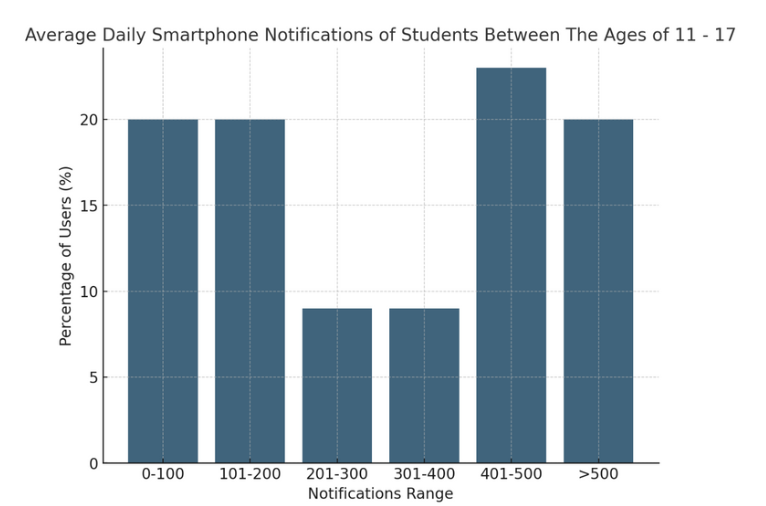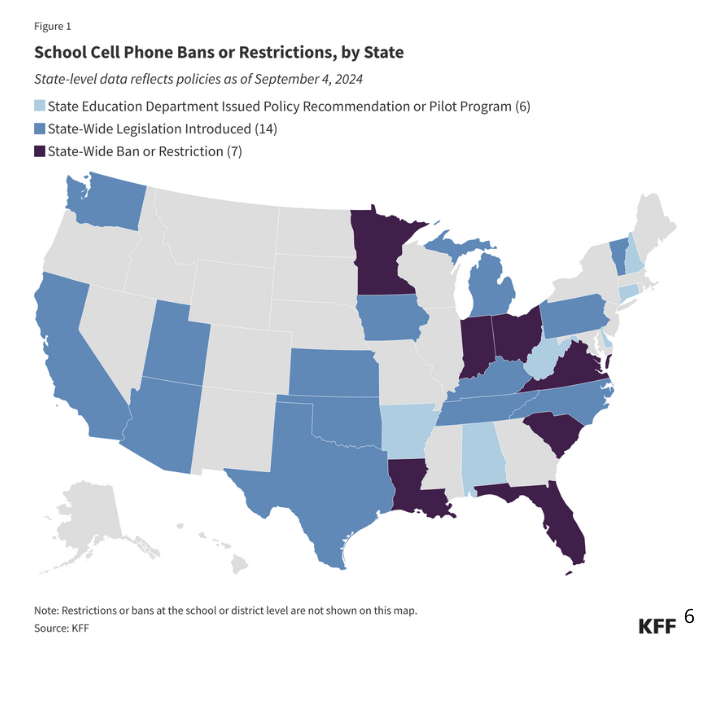Social media and other elements of our connected lives are destroying our ability to concentrate and engage in deep work. According to Johann Hari in his latest book, Stolen Focus, it is not simply a lack of individual willpower that keeps us reaching for our phones and switching from task to task throughout our day. External forces, including the societal shift to blurred lines between work and home, are contributing to our inability to disconnect. Not surprisingly, the collective move to always being available is having a major impact on the lives of children and teens. Social psychologist, author, and Professor Jonathan Haidt brings attention to the growing crisis in his book, The Anxious Generation. He highlights correlations between increased screen time and higher rates of anxiety, depression, and attention disorders among teens. Phone-based behavior patterns, which Haidt defines as prioritizing time on social media, video games, and smartphones over healthy activities such as spending time with friends and family, sleep, physical activity, and reading, are creating serious issues in schools.
According to a 2023 report from Common Sense Media, half of kids between the ages of 11 – 17 received more than 237 messages or alerts on their phones each day, with at least 25% of those distractions occurring during school hours.

In classrooms, the constant stream of notifications and distractions weakens attention spans, which negatively impacts learning and academic performance. Psychologist and author Roy Baumeister explains that willpower, or self-control, operates like a muscle, meaning it can become depleted after exertion. As students face constant digital stimuli, their cognitive resources become depleted, resulting in reduced attention spans, poorer academic performance, and heightened fatigue. Subsequent research by Kathleen Vohs expanded on this, demonstrating that environments rife with distractions—such as unrestricted cell phone use—can lead to decision fatigue. Each time a message or alert is received, deciding whether or not to check the phone, whether to respond, and countless other micro-decisions unrelated to classroom instruction contribute to the mental fatigue.
In academic settings, sustained focus is essential and the distraction of over 60 messages or alerts during the school day for at least half the students, means that at any given moment there is a digital distraction. The cumulative effect of this distraction can lead to diminished classroom participation and poor educational outcomes for all students.
The negative impact of phone-based behaviors in classrooms is not limited to students. We also see willpower depletion in adults as teachers manage classroom dynamics and enforce behavioral standards. Environments requiring constant decision-making drain mental energy. The increased presence of cell phones in the absence of clearly defined guidelines, resources, and support, has placed additional demands on teachers. Tasked with navigating this complex issue on top of their teaching duties, teachers face greater cognitive strain, potentially compromising instructional quality.
Legislative Action on Cell Phone Usage in Schools

In response to the detrimental effects of digital distractions, more than half of states are considering policies regarding cell phone use in K12 schools. When it comes to implementation support, states are taking a variety of approaches including:
- Ohio requires local districts to create a policy addressing the use of cell phones and is drafting a model policy as a resource.
- In addition to providing a model policy for districts, South Carolina launched the “Free to Focus” website, which contains resources for both educators and families and highlights schools where local policies have been successful.
- Virginia created a guidance document with a range of resources after multiple state agencies, including the Department of Behavioral Health & Development worked with the Department of Education to gather input and data statewide.
- Arkansas made funding available to encourage districts to pilot solutions, such as phone lockers or pouches for personal devices, and monitor data on their success.
- Florida prohibits cell phone usage during class time, requires districts to block social media sites for all devices on district wifi, and includes a digital literacy instruction starting in 6th grade.
Local District Adaptation of State Policy
Even as statewide mandates to prohibit cell phones in schools are increasing, they generally provide broad guidelines. Most states leave the details of implementation to local districts. This presents both an opportunity and a challenge to thoughtfully engage with local communities.
In our connected world, the shift to restricting cell phones in schools will inevitably cause a wide range of responses from students, parents, employees, and the wider community. Conversations around the use of cell phones as a tool for safety in emergencies, whether students should be able to use them on campus before and after school, and how best to enforce the rules frequently arise when districts begin to craft a cell phone policy. For administrators seeking additional research, data, and communication templates, the nonprofit Phone Free Schools Movement has compiled a free toolkit with a wide variety of resources on their website.
To give local implementation the best chance of success, the approach to crafting a policy must be thoughtful and comprehensive. As emphasized in The Open System: Redesigning Education and Reigniting Democracy, to solve the biggest challenges, educational systems must actively work to ensure community expertise is surfaced and leveraged for the public good.
With this mindset, typical approaches, such as working groups that meet once a month, can be redesigned to consider schedule cadence to attend to urgency and impact. Strategies for building working groups, such as the open system inclusive democracy framework, can also be explored to build trust with the community.
In states where districts are required or encouraged to create local policies around the implementation of state cell phone mandates, district leaders should ensure policies address the unique needs of their communities.
How can districts leverage the interest in cell phone policy to improve the development process?
Ensure Community Voice
Intentionally seek a variety of perspectives by considering new strategies for building a working group. Include educators, parents, students, and other community members from the beginning of the policy development process to reflect a range of community values and surface potential unintended consequences as policy elements are considered. Include the following in your working group in equal proportion:
- Essential Stakeholders – those whose experience or expertise you need
- Interested Stakeholders – those who want to be involved
- Potential Stakeholders – those whose participation is uncommon but necessary
Build-In Transparency
Articulate which data will be used to monitor the impact of the policy, set clear timelines for both reporting data publicly and policy review, and plan for future adjustments since technology and behaviors will continue to evolve.
Age & Need Specific Guidelines
Create policies that account for the developmental needs of students at different educational stages. Additionally, consider students who may need access to specific devices for educational, medical, or emergency reasons.
Clear Communication
Establish clear, consistent guidelines for enforcement across the district to ensure all stakeholders understand their roles. Acknowledging safety concerns from parents can be used to shape changes to current communication structures within the district.
Educational Technology Integration
Analyze the district technology plan to prioritize and re-allocate resources to support the shift away from personal devices to district owned technology and tools. Consider how the proposed policy will impact resource allocation for storage of personal devices.
Support Teachers
Equipping teachers with strategies for managing distractions will help integrate policy enforcement with instructional practices; however, it is crucial that policies do not place undue enforcement burdens on teachers. Clear and consistent policies can reduce the need for constant teacher intervention and prevent inconsistent enforcement.
By prioritizing inclusive collaboration, districts can ensure policies are not only effective but also reflect the values of the community. As technology continues to evolve, policies can serve as adaptable frameworks, allowing schools to respond to future challenges without sacrificing student well-being or instructional quality.
In addition to benefiting students, well-crafted policies will reduce the cognitive burden on teachers, freeing them to focus more on instruction rather than the constant enforcement of rules. Ultimately, the goal is to foster healthier learning environments, equipping students with the focus, discipline, and resilience necessary for lifelong success.
Endnotes:
- Hari, J. (2022). Stolen focus: why you can’t pay attention–and how to think deeply again. Crown.
- Haidt, J. (2024). The anxious generation: How raised expectations, increased competition, and the decline of play are crippling our kids. Penguin Press.
- Radesky, J., Weeks, H.M., Schaller, A., Robb, M., Mann, S., and Lenhart, A. (2023). Constant Companion: A Week in the Life of a Young Person’s Smartphone Use. San Francisco, CA: Common Sense. https://www.commonsensemedia.org/sites/default/files/research/report/2023-cs-smartphone-research-report_final-for-web.pdf
- Baumeister, R. F., & Tierney, J. (John M. (2012). Willpower : rediscovering the greatest human strength. Penguin Press.
- Vohs, K. D., Baumeister, R. F., Schmeichel, B. J., Twenge, J. M., Nelson, N. M., & Tice, D. M. (2008). Making choices impairs subsequent self-control: a limited-resource account of decision making, self-regulation, and active initiative. Journal of Personality and Social Psychology, 94(5), 883-898. https://doi.org/10.1037/0022-3514.94.5.883
- Panchal, N.,& Zitter, S., A Look at State Efforts to Ban Cellphones in Schools and Implications for Youth Mental Health, KFF, September 5, 2024, https://www.kff.org/mental-health/issue-brief/a-look-at-state-efforts-to-ban-cellphones-in-schools-and-implications-for-youth-mental-health/
- Tran, D., & Ullman, E. (2023). The Open System: Redesigning Education and Reigniting Democracy. Cambridge, MA: Harvard Education Press